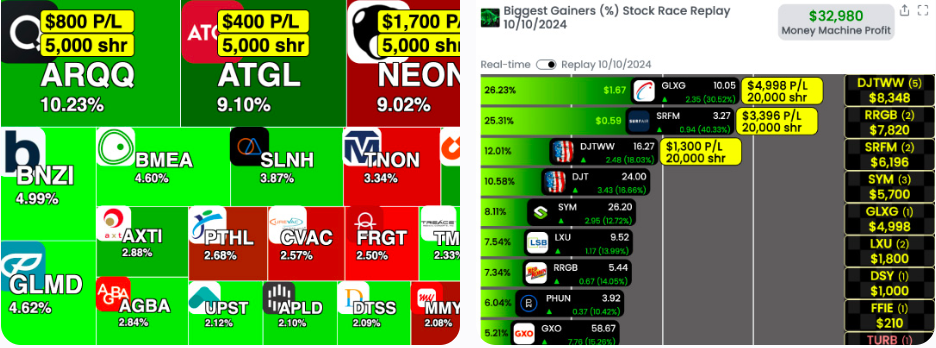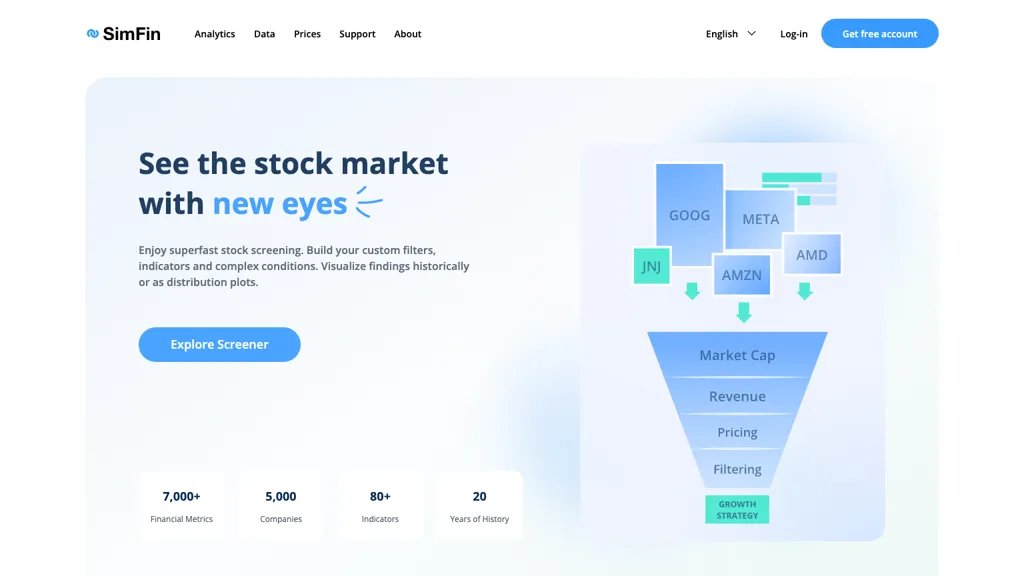20 Good Tips On Choosing AI Stock Investing Analysis Websites
20 Good Tips On Choosing AI Stock Investing Analysis Websites
Blog Article
Top 10 Tips For Assessing The Market Coverage Of Ai Trading Platforms For Predicting Stocks
When looking at AI trading platforms that forecast or analyze stocks, market coverage is a key aspect to take into consideration. It determines what assets and markets are readily available. With a platform that offers comprehensive coverage, you can diversify your portfolio and make the most of opportunities across the globe. It is also possible to adapt to different trading methods. These are the top 10 tips to evaluate the market coverage of these platforms.
1. Evaluate Supported Asset Classes
Stocks: Ensure that your platform supports major stock exchanges like NYSE, NASDAQ LSE and HKEX, and that it includes small, mid and large cap stocks.
ETFs: Check if the platform supports a wide selection of ETFs to provide a diverse exposure to regions, sectors, or even themes.
Options and Futures: Check whether the platform is compatible with derivatives such as options or futures, as well as other leveraged products.
The commodities and forex market: Check whether the platform offers forex pairs and precious metals, energy commodities, and agricultural products.
Cryptocurrencies: Verify if the platform you are using is compatible with the major copyright, like Bitcoin and Ethereum as well as alternative coins.
2. Make sure you check the area of coverage
Global markets - Ensure that the platform has the capacity to serve every major market around the world including North America (including copyright), Europe, Asia-Pacific markets as well as emerging ones.
Regional focus Verify that the platform is specialized in certain markets or regions that align with your trading interest.
Local exchanges - Check to see if there are local or regional exchanges in relation to your location and strategy.
3. Delayed Data vs. Delayed Data
Real-time data - Ensure that the platform offers real-time market information that will aid you in making quick decisions, especially for active traders.
Data that has been delayed: Check whether delayed information is available at no cost or discounted that could be sufficient for investors who have an eye on the long term.
Data latency. Check if the platform minimizes the time it takes to process real-time feeds, especially for high-frequency trading.
4. Examine the historical data availability
The breadth and depth of historical data: Make sure that the platform has ample historical data available (e.g. for at minimum 10 years) for backtesting.
Examine the detail of historical data.
Corporate actions: Examine to see if data is accounted for in the past. Dividends or stock splits all other corporate actions need to be included.
5. Check Market Depth and Order Books
Platforms must provide Level 2 data (order-book depth) to improve price discovery and execution.
Be sure to check for live bidding and asking spreads. This will guarantee that the pricing is correct.
Volume data: Check if the platform provides specific volume data to analyze market activity and liquidity.
6. Assess how much coverage is available for Indices and Sectors
Major indices: Ensure that your platform supports major indices like the S&P 500 (e.g. NASDAQ 100 or FTSE 100), for benchmarking using indexes.
Industry-specific data: If you want to do a more targeted analysis, look into whether there are any data available for certain sectors.
Custom indexes. Verify that the platform allows you to create and keeping track of custom indices that meet your needs.
7. Evaluate Integration with Sentiment and News Data
News feeds - Ensure that the platform is integrating live news feeds with market-moving news from trusted (e.g. Bloomberg or Reuters) sources.
Use the tool's sentiment analysis based on data from news, social media or any other source.
Event-driven trades: Verify the platform's support for event-driven trades (e.g. reports on economic data, earnings announcements).
8. Check for Multimarket Trading Abilities
Cross-market trading: Make sure the platform supports trading across multiple markets and asset classes through one interface.
Currency conversion: Verify that the platform supports multicurrency accounts as well as currency conversions for international trading.
Check for support of time zones.
9. Assessment of Alternative Data sources
Alternative data: See whether the platform is able to integrate alternative data sources (e.g. satellite imagery, credit card transactions) for unique insight.
ESG data - Check that the platform is able to provide environmental, governance, and social information (ESG). This is essential for a the socially conscious investment.
Macroeconomic data: Make sure the platform offers macroeconomic indicators that can be used to analyze fundamental issues (e.g. GDP and inflation rates, as well as interest rates).
10. Review Market Feedback and User Reviews. Reputation
Feedback from users: Read user feedback to evaluate the platform's reliability and market coverage.
Check for the platform's industry reputation. This includes awards and recognition by experts in the area.
Seek out testimonials that show the platform's effectiveness in certain markets and asset classes.
Bonus Tips
Trial period - You can use the demo or trial for free to check out the coverage of data and market coverage.
API access: Verify whether the platform's API allows access to market data programmatically for custom analysis.
Support for customers. Be sure the platform will provide assistance with regard to market or data queries.
By following these tips and techniques, you will be able to assess the market coverage offered by AI trading platforms that predict or analyze stocks Be sure to select one that has access to the markets and data necessary to be successful in trading. Comprehensive market coverage lets you to diversify and explore the possibilities of your portfolio. It also allows you to adjust to changes in the market. Read the top click here for ai for investing for blog tips including ai stock picker, ai for trading, market ai, best ai trading app, ai investment platform, ai for stock trading, stock ai, options ai, best ai trading app, ai stock market and more.
Top 10 Things To Consider When Evaluating Ai Trading Platforms' Educational Resources
Reviewing the educational tools offered by AI-driven stock prediction systems and trading platforms is essential for those who use them to learn how to effectively use the platform, understand results, and make educated trading choices. Here are ten suggestions on how to assess the quality and utility of these tools:
1. Complete Tutorials, Guides, and Instructions
Tips: Make sure the platform has simple tutorials or user guides for beginners and experienced users.
What's the reason? Clear directions can help users navigate and understand the platform.
2. Video Demos as well as Webinars
You may also search for webinars, training sessions in real time or videos of demonstrations.
Why? Interactive and visual content can help you comprehend difficult concepts.
3. Glossary
Tips - Make sure the platform provides a glossary and/or definitions for the most important AI and finance terms.
Why: It helps beginners to comprehend the terms of the platform, and especially those who are new to the platform.
4. Case Studies: Real-World Examples
Tips: Check whether the platform offers instances of how the AI models have been utilized in real-world situations.
The reason: Examples of practical use demonstrate the power of the platform and aid users relate to its applications.
5. Interactive Learning Tools
Tips: Search for interactive tools such as games, simulators or sandboxes.
Why is that interactive tools allow users to test and practice their skills without risking money.
6. Content that is regularly updated
Tip: Check whether educational materials reflect any modifications to the market, regulations or any new features.
The reason: outdated information can lead you to make misunderstandings and make incorrect use of.
7. Community Forums with Support
Find active forums for community members and support groups, where you can ask questions to other members or share ideas.
The reason: Peer-to-peer support as well as experienced guidance can help improve learning and problem solving.
8. Accreditation and Certification Programs
Make sure the platform is equipped with accreditation and certification programs.
What is the reason? Recognition formal of knowledge can increase credibility and motivate users to increase their knowledge.
9. User-friendliness and accessibility
Tip: Assess how user-friendly and accessible the educational resources are (e.g., portable-friendly PDFs, downloadable PDFs).
The reason is that it's easy for users to learn at their own speed.
10. Feedback Mechanism for Educational Content
Verify if the platform permits for users to leave feedback on the materials.
The reason is that the feedback of users helps to improve the quality and relevancy of the content.
Learn through a range of ways
Make sure the platform has various formats for learning that will suit your different types of learning (e.g. text, audio or video).
By evaluating these aspects carefully, you can decide whether you are satisfied with the AI stock trading platform and prediction software provide the best educational resources that allow you to fully utilize their potential and make educated decisions. Take a look at the top rated ai stock investing for blog advice including best ai for stock trading, best ai stocks, best ai stocks, free ai stock picker, can ai predict stock market, ai stock trader, ai trading tool, ai trading tool, ai stock price prediction, free ai tool for stock market india and more.